The VISATON NoBox BB Loudspeaker Kit
Thinking Outside the Box!
©Dick Olsher
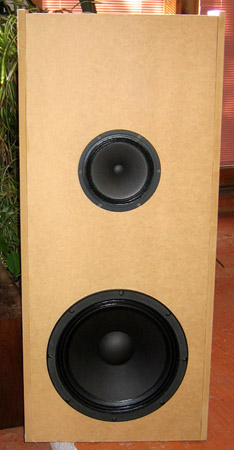
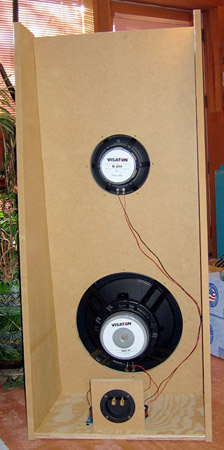
Intro
Under review is an open baffle (OB) loudspeaker kit from VISATON, a German firm with 30 years of experience in the fields of acoustics and loudspeaker technology, and probably the largest and most important speaker kit player in the international Do-It-Yourself (DIY) arena today. The NoBox is only one of many kit offerings in the VISATON catalog and is designed to address the resurgence of interest in dipole designs. A single kit includes everything needed (except for the baffle) to construct one speaker channel: drivers, fully assembled crossover board, terminal cup, speaker cable, and hardware. I would rate this project as easy to build, and eminently suitable for novice DIYers.
Open Baffles Demystified
Before we plunge into the details of the kit, it would be worthwhile to examine the technical issues of OB speakers. First, it is important to make a distinction between designs where only the midrange is operated in dipole fashion and those where the woofer and midrange are both placed on an open baffle. The latter case, a full-range OB, as represented by the NoBox, must deal with the technical problem of obtaining sufficient bass extension in the face of inevitable front-to-back cancellation defined by the effective size of the open baffle. However, an OB design, in my book, is first and foremost about the midrange. There has been much written about dipole bass and its presumed advantages. However, unboxing the midrange is in fact the major advantage. One of the main reasons the QUAD-57 electrostatic loudspeaker, or for that matter any other good planar speaker, sound so natural (i.e., non-boxy) in the midrange is directly due to the absence of boxy cavity resonances that serve to obscure midrange detail.
And there is more to it than that. The reflected soundfield in a domestic listening environment is typically deficient in midrange energy. That is because most speakers’ power response into the room becomes non-uniform above about 2 kHz, as they begin to beam in the upper midrange. Since the soundfield at the listening seat is a composite of direct and reflected sound, any coloration in the reflected soundfield will affect the perceived balance. Note that at least 50% of the energy at the listening seat in most rooms is due to reflected sound. Using a full-range driver as a dipole radiator on an open baffle allows the backside of the driver to add 3 dB of additional midrange energy to the speaker’s off-axis response and results in a better midrange balance at the listening seat. However, care must be taken with placement. Placing a dipole too close to the rear wall creates undesirable cavity resonances and comb filter effects within the initial 10 mS time arrival window that is used by the auditory system to process pitch and timbre. My recommendation is to allow at least a 5-foot spacing from the rear wall, so that rear reflections are delayed at least 10 mS (sound travels about 1 foot in 1 mS) relative to the direct sound. Giving a dipole room to breath results in a spacious soundstage and a wonderful depth perspective. Thus, from a practical standpoint, dipoles work best in medium to large sized rooms, and in situations where domestic considerations allow optimum spacing from the rear wall.
The OB made its first appearance in the radio receivers of the 1920s, mainly for reasons of convenience and cost. The baffle was typically folded back to form a five-sided box with an open back. Unfortunately, this represents the worst possible OB design, as its primary advantage – lack of cavity resonances - is negated. However, a slight fold back of the front baffle (in the manner implemented by VISATON) is a good idea as it reduces the size of the front panel while avoiding cavity colorations. With the advent of closed and vented box designs, the OB became stereotyped as unsophisticated and was relegated to the backwater of speaker design. It was left to Electrovoice’s Raymond Newman (AES Journal, Vol. 28, No. 1/2, 1980) to undertake a modern re-examination of the design in the late 70s in light of the Thiele-Small speaker alignment theory which was all the rage in those days. His starting point was a 5.5 foot effective diameter baffle (168 cm), an important dimension that defines a half-wavelength at 100 Hz and represents about as large a baffle as he surmised most music lovers would be willing to accommodate in a domestic listening environment. Such a baffle would be expected to exhibit a 100 Hz cutoff frequency, as sound waves, radiated out of phase from the back of the woofer, wrap around the baffle at lower frequencies and cause cancellation of acoustic output. Newman’s research led to several important observations, which will be discussed next.
First, the baffle should be designed so that it is flush with the floor, rather than being elevated off the ground plane. This generates a mirror image of the baffle in the floor plane, effectively doubling its area and increasing the effective baffle dimension by the square root of 2 (a factor of 1.414). In this manner, the baffle may be decreased from 168 cm to 119 cm without affecting the bass cutoff. Second, unlike the situation with standard box designs, large, high-acoustic compliance woofers may be used without increasing the size of the baffle. In other words, for a fixed baffle size, the sensitivity of an OB design may be increased by using a larger woofer or a line array of smaller woofers. There is no size penalty involved in using a 15-inch woofer vs. an 8-inch woofer as there is with conventional box designs. Third, a high Qt (0.6 to 0.7) driver gives the most extended bass response for a given baffle size. Some designers have opted for even higher Qt woofers; Bob Carver’s “Amazing” loudspeaker comes to mind. However, the quality of the bass ends up being too loose and under damped at Q factors near 1. The good news is that the system response drops at a rate of only 6 dB per octave below the open baffle’s bass cutoff frequency down to the woofer’s resonance frequency. Below resonance, the drop in response accelerates to 18 dB per octave. Unfortunately, it is not possible to design a woofer with high-efficiency, high Qt, and low free-air resonance. Still, this means that with gentle EQ it should be possible to extend the response of a real-world woofer mounted on a 100 Hz baffle by another octave to near its resonance frequency. EQ below the resonance frequency is not practical due to the extreme excursion demands placed on the woofer.
Finally, the figure-of-eight directivity of the bass output (less energy directed at the side walls and ceiling) may be useful in some listening environments to reduce the effect of room modes and produce more even deep bass. As is well known, below about 200 Hz, bass energy distribution in small rooms is very uneven, with many peaks and valleys related to the room dimensions. It has been argued by some (e.g., Gradient Loudspeakers) that because a dipole radiator excites fewer room modes relative to a conventional box speaker with its omni-directional bass output, bass response at the listening seat should exhibit a smoother response. While it is not clear to me that this represents a valid conclusion for all rooms and setups, one thing is certain: a dipole woofer is bound to sound different relative to that of a box speaker.
The Nelson Pass constant current amplifiers from First Watt offer another means of enhancing the bass output of a dipole woofer. In particular, the model F2 works particularly well with the VISATON NoBox providing a bass boost around the woofer’s resonance frequency. To illustrate the point, one of the VISATON BGS-40 15-inch woofers, mounted on the NoBox baffle, was measured near field (to eliminate room effects), driven first by a conventional 300B SET amplifier, and then by the constant-current F2. In both cases, a 2nd order low-pass network consisting of a series 13 mH steel-laminate coil and a 200 uF shunt capacitor was used to roll off the high frequencies. The measured frequency response is shown in the next Figure.
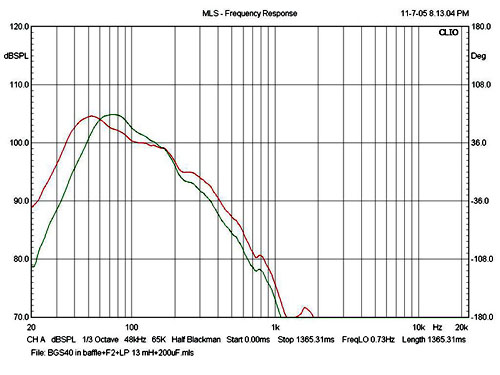 |
The green curve gives the response with the voltage controlled amplifier, while the red curve is the resulting response with the F2 in the chain. Bass extension is flat to about 60 Hz with the conventional amplifier. Not bad for what is nominally a 90 to 100 Hz open baffle. On paper, the woofer’s Qt is 0.31, and one would think it to be a bit overdamped for OB applications. But with the added low-pass network, and the coil’s DC resistance being in series with the woofer’s voice coil, its effective Qt is pushed higher thus accounting for the bass extension to 60 Hz. The F2, on the other hand, goes where no voltage controlled amplifier can possibly go: bass response is flat to about 40 Hz – an astounding result for such a modestly sized open baffle. Keep in mind that these are near field results. In-room response (presented later) is inevitably distorted by room modes.
Driver Complement
The NoBox is a two-way design. The main attraction is the B-200 8-inch full range, which features a lightweight paper cone, an aluminum die cast basket, a 1-inch voice coil, and a maximum linear excursion of +/- 3.5 mm. This driver is not unique to the NoBox, and is also used in several other VISATON models such as the Solitude and Quadro. The matching 15-inch woofer (BGS-40) also features a die-cast aluminum basket, paper cone, high-power handling, and a maximum excursion of 16 mm.
The Crossover Network
The crossover schematic is shown schematically and pictorially in the next two Figures. The crossover frequency is 250 Hz. An EQ network consisting of a 1.5 mH coil in parallel with a 10-Ohm resistor is used to level out the B-200’s response above 1 kHz, at the cost of reduced overall sensitivity.
 |
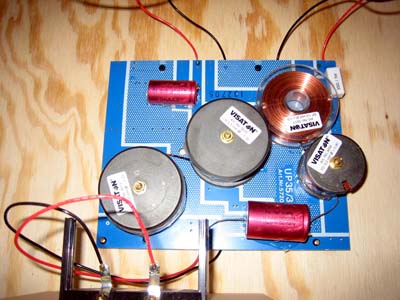 |
The crossover board comes fully stuffed with OK quality parts. All you need to do here is to connect the board to the input terminals and drivers. Rather than use the cable provided, I opted for Welborne Labs (www.welbornelabs.com/) Teflon insulated hookup wire (18 ga. Solid-core copper). Packing for the board was a bit skimpy and it got jostled around during shipping to the point that one of the 47 uF electrolytic caps broke loose from the silicone glue anchoring it to the board. This is one part that merits serious consideration for an upgrade, as it is in series with the B-200 full range (see comments under sonic impressions).
Baffle Construction
The following Figures detail the baffle construction details.
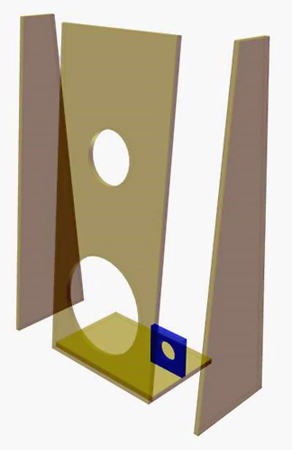
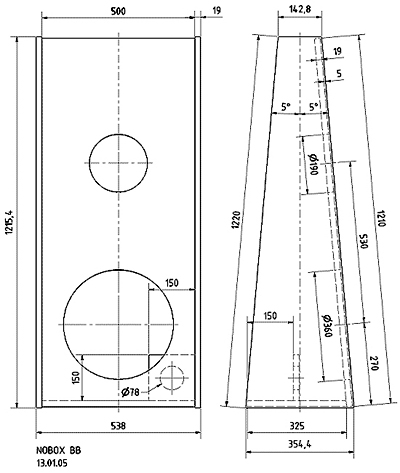
There are actually two versions of the NoBox open baffle detailed in the kit instructions. Since my goal was to get a prototype up and running as quickly as possible, I opted for the plain vanilla Version #1. Version #2 is functionally identical to the basic baffle, except for improved cosmetics: edges are finished with solid wood strips and a grille frame is specified so that the entire front can be covered with fabric. The baffle material is called out as 19 mm chipboard or MDF. I decided on unfinished ¾” MDF, though if I were building these as keepers, I would definitely settle on veneer finish and a thicker MDF or even a two-layer type construction to minimize baffle flexing. My baffles were built for me by a local friend and an experienced woodworker, so I cannot specifically comment on construction related issues.
Measured Performance
The Figures below show the in-room frequency response of the NoBox measured at about 4 feet from the front of the baffle, on-axis with the B200.
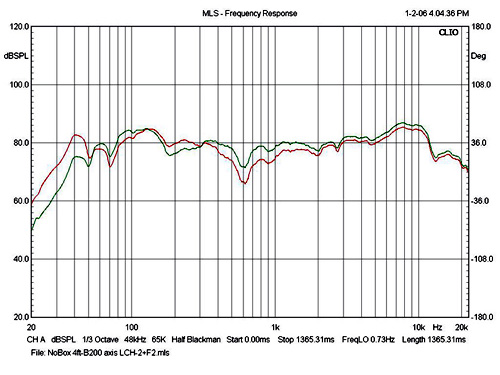 |
The green curve shows the response of the NoBox when driven by a conventional voltage controlled power amplifier, while the red curve shows the response obtained with the First Watt model F2 current source amplifier. The bass response extends to at least 40 Hz in-room when the NoBox is driven by the F2. The treble range above 10 kHz appears to be rather uneven and the core of the midrange is slightly recessed. However, the transition region around the crossover frequency is quite smooth, indicating successful driver integration.
Sonic Impressions
If you thought that bass balance would be an issue, in the context of what is after all a modestly sized open baffle, you would be way off the mark. This is no lean, all bones, scrawny performer. The NoBox will show you plenty of harmonic fat. The bass balance was full bodied, featuring a well fleshed out upper bass that projected the power range of an orchestra with authority. Bass lines sounded tight and unhindered by boxy resonances, though performance in this respect was amplifier dependent. Not surprisingly, the First Watt F2 offered the most refined and extended bass range, while voltage-controlled amplifiers lost some punch and detail. While on the subject of matching power amplifiers, most of the time I was satisfied with 10 wpc, but I suspect that the NoBox would be happiest with a 50 wpc power reserve.
The tonal balance was a bit recessed through the midrange and lacked sufficient air and sparkle in the treble. It would appear that the B-200 full range is struggling above 10 kHz, and its performance over the uppermost octave is far from state-of-the art. In its defense, however, the B-200 is an exceptionally easy to listen to driver. There is an organic and cohesive character about the way it projects the harmonic tapestry through the mids and lower treble. It does female vocals exceptionally well, a high compliment indeed. In many ways it reminded me of the older Fostex FE208 sigma twin-cone and offers the same sort of natural voicing. The NoBox, despite its treble shortcomings, reaffirmed my commitment to full range drivers. There are so many audiophile speakers out there with a split personality. Female voice is typically split between a cone mid-woofer and a dome tweeter, whose sonic personalities differ greatly, and it is left as an exercise to the listener to re-constitute a believable image from two disparate sources. In the case of the B-200, it was so easy to embrace the presentation as the real thing without the need for any Zen meditation or the intervention of alcohol. Image outlines snapped together tightly within the confines of a spacious soundstage, making it easy to point a finger at a particular instrument.
Even after a reasonable break-in period, harmonic textures retained a grainy quality. I became suspicious that, to a significant extent, this was due to the impact of the 47 uF electrolytic capacitor in the high-pass crossover network, in series with the B-200. I decided to replace it with a Black Gate 47 uF speaker cap, which I just happened to have on hand; it is hard to find these days, so you may want to experiment with your favorite brand. The cap substitution alleviated much of the grain, though I would still decline to describe the mids as velvety in texture. Long-term listening also highlighted deficiencies in transient speed and detail resolution. The B-200 simply lacks the speed of attack and resolution of, for example, the Lowther DX4 with which I am very familiar. This was most obvious when trying to resolve complex harmonies or follow reverberant decay clear down to the noise floor of a recording; clarity was diminished and low-level detail was obscured. But, to be fair, one needs to consider the price differential between the B-200 and DX4.
Conclusion
Overall Rating: 3.25 out of 5
The VISATON NoBox thinks outside the box! It is an affordable, well-engineered, and easy to build loudspeaker kit that will introduce DIYers to the joys of dipole radiators and full range drivers. It is important to emphasize that, as with other dipoles, the NoBox requires adequate breathing space from the rear wall. You might be able to get away with three feet, but I recommend a minimum of five feet. I have enjoyed its cohesive presentation with both matching tube and solid-state single-ended amplifiers. But, without a doubt, it was the First Watt F2 that brought the best out of the NoBox. I suspect that it might also do very well when partnered with a 40 to 50 wpc push-pull tube amplifier, though I have yet to try such a coupling.
North American Distributor:
SOLEN INC.
St-Hubert, QC J3Y 7T9
CANADA
Tel: 450-656-2759
Fax: 450-443-4949
Website: www.solen.ca/
Retail price: US$423.98 per channel
Manufacturer:
VISATON, Germany
Website: www.visaton.com/
Specifications:
Rated power: 200 Watts maximum; 300 Watts nominal
Nominal impedance: 4 Ohm
Frequency response: (-10 dB) 32 – 20,000 Hz
Sensitivity: 90 dB (2.83V/1m)
Dimensions: 121.5H x 53.8W x 35.5D cm